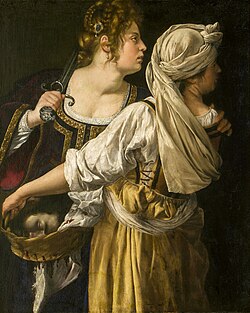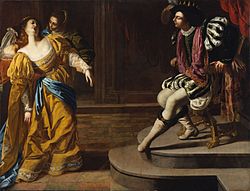The following is an incomplete list of works by Artemisia Gentileschi . Catalogue numbers abbreviated "WB" are taken from the 1999 publication by Raymond Ward Bissell, [1] and number abbreviated "MET" are from the 2001 publication by the Metropolitan Museum of Art. Other attributions are taken from Jesse Locker's The Language of Painting. [2] [3] Further references are available on the Bibliography on Artemisia Gentileschi.
| image | name | year | collection | dimensions | inventory nr. | catalogue code |
|---|---|---|---|---|---|---|
 | Susanna and the Elders | 1610–1611 | Schloss Weißenstein | 170 x 119 cm. | 191 | MET (51), WB (2) |
 | Madonna and Child | 1610–1611 | Galleria Spada | 116.5 X 86.5 cm. | 166 | MET (52), WB (X-19) |
 | Cleopatra | 1611–1612 | Private Collection | 118 x 181 cm. | MET (53), WB (X-6) | |
 | Judith Slaying Holofernes | 1611–1612 | Museo Nazionale di Capodimonte | 158.8 x 125.5 cm. | MET (55), WB (4) | |
 | Danae | 1612 | Saint Louis Art Museum | 40.5 X 52.5 cm. | 93:1986 | MET (54), WB (X-7) |
 | Portrait of a Nun | 1613–1618 | Private Collection | 70 × 52.5 cm. | MET (Figure 114.) | |
 | Allegory of Inclination | 1615 | Casa Buonarroti | 152 × 61 cm. | MET (Figure 110.), WB (8) | |
 | Self-Portrait as a Female Martyr | c. 1615 | Private Collection | 32 X 24.7 cm. | MET (56), WB (7) | |
 | Self-Portrait as Saint Catherine of Alexandria | 1615–1617 | National Gallery, London | 71.5 cm x 71 cm | NG6671 | |
 | Self-Portrait as a Lute Player | 1616–1618 | Wadsworth Atheneum Villa Medici | 30 x 28 cm | MET (57) | |
 | Mary Magdalene | 1616–1617 | Palazzo Pitti, Florence | 146.5 x 108 cm | MET (58), WB (10) | |
 | Saint Catherine of Alexandria | c. 1618–1619 | Uffizi The National Gallery [4] | 77 x 62 cm | 8032 | MET (59), WB (6) |
 | Judith and her Maidservant | c. 1618–1619 | Palazzo Pitti, Florence | 14 x 93.5 cm | MET (60), WB (5) | |
 | Allegory of Painting | 1620s | Musée de Tessé, Le Mans | 95.5 x 133 cm | MET (64) | |
 | Mary Magdalene as Melancholy | 1620s | Museo Soumaya | 136.3 × 100.3 cm. | MET (Figure 128.), WB (17) | |
 | Saint Cecilia | c. 1620 | Galleria Spada | 108 X 78.5 cm. | MET (63), WB (X-28) | |
 | Mary Magdalene in Ecstasy | 1620 | private collection | 81 x 105 cm cm. | G. Pupi | |
 | Jael and Sisera | 1620 | Museum of Fine Arts, Budapest | 86 X 125 cm. | MET (61), WB (11) | |
 | Judith Slaying Holofernes | 1620–1621 | Uffizi | 86 X 125 cm. | MET (62), WB (12) | |
 | Susanna and the Elders | 1622 | Burghley House | 162.5 x 121.9 cm. | MET (65), WB (X-42) | |
 | Portrait of a Gonfaloniere | 1622 | Palazzo d'Accursio | 208 x 128 cm. | MET (66), WB (13) | |
 | Lucretia | c. 1623–1625 | Collection Gerolamo Etro, Milan | 54 x 51 cm. | MET (67), WB (3) | |
 | Christ Blessing the Children | c. 1624–1625 | Church of Sant'Ambrogio e Carlo al Corso, Rome | 134.6 × 97.7 cm. | MET (Figure 132.) | |
 | Penitent Magdalene | c. 1625–1626 | Seville Cathedral | 122 x 96 cm. | MET (68), WB (16) | |
 | Judith and Maidservant with Head of Holofernes | c. 1625–1627 | Detroit Institute of Arts | 182.2 X 142.2 cm. | 52.253 | MET (69), WB (14) |
 | Lucretia | 1627 | J. Paul Getty Museum | 92.9 x 72.7 cm. | 2021.14 | |
 | Venus and Cupid | c. 1625–1630 | Virginia Museum of Fine Arts | 94 x 144 cm. | 2001.225 | MET (70), WB (18) |
 | Aurora | 1625–1627 | Private Collection | 218 x 146 cm. | MET (Figure 96.), WB (15) | |
 | Esther before Ahasuerus | c. 1628–1635 | Metropolitan Museum of Art | 208.3 × 273.7 cm. | 69.281 | MET (71), WB (28) |
 | Allegory of Painting | 1630s | Private Collection | MET (Figure 97.) | ||
 | Penitent Magdalene | 1630s | Private Collection | 49 x 39.7 cm. | MET (Figure 98.) | |
 | Madonna and Child | c. 1630 | Palazzo Pitti, Florence | 118 x 86 cm. | 2129 | MET (Figure 107.), WB (1) |
 | Susanna and the Elders | c. 1630 | Nottingham Castle | 162.5 x 121.9 cm. | NCM 1964–77 | MET (65 (related pictures: Nottingham)) |
 | Annunciation | 1630 | Museo Nazionale di Capodimonte | 257 x 179 cm. | Q375 | MET (72), WB (24) |
 | Penitent Magdalene | c. 1630–1632 | Private Collection | 65.7 x 50.8 cm. | MET (73), WB (9) | |
 | The Sleeping Christ Child | 1630–1632 | Museum of Fine Arts, Boston | 12.4 × 17.5 cm | 2022.102 | |
 | Saint Catherine of Alexandria | c. 1627–1635 | Nationalmuseum, Stockholm | 90 x 75.4 cm. | NM 7538 | |
 | Corisca and the Satyr | c. 1630–1635 | Private Collection | 155 x 210 cm. | MET (74), WB (30) | |
 | Self Portrait | c. 1630–1635 | Palazzo Barberini, Rome | 98 x 74.5 cm | 1952 (F.N. 33598) | Locker (Figure 5.2) |
 | Samson and Delilah | 1630–1638 | Palazzo Zevallos, Naples | WB (35) | ||
 | Clio: the Muse of History | 1632 | Palazzo Blu | 127.6 x 97.2 cm. | MET (75), WB (27) | |
 | Cleopatra | c. 1633–1635 | Private Collection | 117 x 175.5 cm. | MET (76), WB (22) | |
 | Nativity of St. John the Baptist | c. 1633–1635 | Museo del Prado | 184 X 158 cm. | P00149 | MET (77), WB (32) |
 | Lot and his Daughters | c. 1635–1638 | Toledo Museum of Art | 230.5 x 183 cm. | 1983.107 | MET (78), WB (39) |
 | The Martyrdom of St Januarius in the Amphitheatre at Pozzuoli | c. 1636–1637 | Museo Nazionale di Capodimonte | 300 x 200 cm. | MET (79), WB (33b) | |
 | Adoration of the Magi | c. 1636–1637 | Museo Nazionale di Capodimonte | 300 × 180 cm. | MET (Figure 142.), WB (33c) | |
 | Saint Proculus of Pozzuoli and his mother Santa Nicaea | c. 1636–1637 | Museo Nazionale di Capodimonte | 300 × 180 cm. | MET (Figure 143.), WB (33a) | |
 | David and Bathsheba | c. 1636–1638 | Columbus Museum of Art | 265.4 x 209.6 cm. | 1967.006 | MET (80), WB (37) |
 | Bathsheba | 1638 | Private Collection | MET (80 (related pictures: formerly Ramunni, Naples, ex-Leipzig)), WB (40) | ||
 | Self-Portrait as the Allegory of Painting | c. 1638–1639 | Royal Collection, Windsor Castle | 96.5 x 73.7 cm. | RCIN 405551 | MET (81), WB (42) |
 | Susanna and the Elders [5] | c. 1638–1640 | Royal Collection, Windsor Castle | 189 x 143 cm. | ||
 | Judith and Maidservant with Head of Holofernes | c. 1640s | Museo di Capodimonte, Naples | 272 X 221 cm. | Q377 | MET (69 (related pictures: Museo di Capodimonte)), WB (48c) |
 | Judith and her Maidservant (Cannes) | c. 1640s | Musée de la Castre, Cannes | 235 x 172 cm. | 2006.O.751 | WB (47), Locker Figure 3.31 |
 | Saint Apollonia | 1642–1644 | Museo Soumaya | 74.3 cm × 57 cm (29.3 in × 22 in) | ||
 | David and Bathsheba | 1645 | Prussian Palaces and Gardens Foundation Berlin-Brandenburg | 265.4 x 209.6 cm. | MET (80 (related pictures: Neues Palais, Potsdam)), WB (48a) | |
 | Lucretia | 1645–1650 | Neues Palais in Potsdam | 261 × 226 cm. | MET (Figure 99.), WB (48b) | |
 | David and Bathsheba | 1645 | Palazzo Pitti, Florence | 286 x 214 cm | MET (80 (related pictures:Palazzo Pitti)) | |
 | Bathsheba | 1640–1645 | Private Collection | MET (80 (related pictures: Haas collection, Vienna)), WB (45) | ||
 | Venus Embracing Cupid | 1640s | Private Collection | 121 x 160 cm. | MET (82), WB (31) | |
 | Susanna and the Elders | 1649 | Moravian Gallery in Brno | 205 x 168 cm | MET (83), WB (50) | |
 | Susanna and the Elders | 1650 | Bassano Civic Museum | 168 × 112 cm | MET (83 (related pictures: Bassano del Grappo)); Locker, Figure 6.1 | |
 | Virgin and Child with a Rosary | 1651 | El Escorial | 58 x 50 cm | MET (84), WB (51) | |
 | Susanna and the Elders | 1652 | Pinacoteca Nazionale di Bologna | 200.3 × 225.6 cm | WB (L-104) |